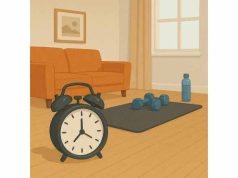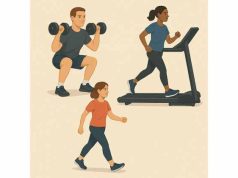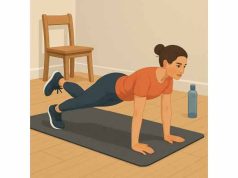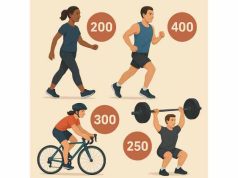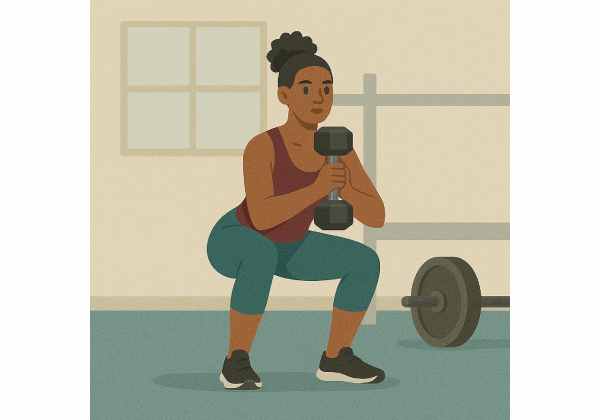
Strength training is the backbone of a sustainable weight-loss plan. It protects lean muscle, keeps your metabolism steady as the scale moves, and builds a body that feels capable—not just lighter. This guide gives you a clear three-day weekly plan, simple technique cues, and practical progressions so you know exactly what to do next week. You will also learn how to pair lifting with steps and nutrition to keep results moving without burnout. For a broader roadmap that shows how strength, cardio, and daily movement fit together, see our exercise framework for weight loss.
Table of Contents
- Why strength supports fat loss
- Strength training for weight loss basics
- 3-day beginner plan
- Equipment, sets and progressions
- Technique and safety essentials
- Nutrition, recovery, and NEAT
- Common mistakes and fixes
- Frequently Asked Questions
Why strength supports fat loss
If your goal is to lose fat and keep it off, strength training is not optional—it is the lever that preserves muscle while you eat fewer calories. Muscle is metabolically active tissue; it accounts for much of the energy you burn at rest, and it lets you do more overall activity without feeling wrecked. When people diet without lifting, they usually lose a mix of fat and lean mass. That makes future maintenance harder and increases the odds of regaining weight.
Strength work also shapes how your body handles fuel. Resistance exercise improves insulin sensitivity, which helps shuttle nutrients into muscle rather than being stored as fat. It supports joint health by strengthening tendons and connective tissues. Over time, that resilience lets you accumulate more steps and optional cardio without aches cutting sessions short.
From a practical standpoint, strength training is time-efficient. Three focused sessions per week—each 35–55 minutes—deliver a strong signal to keep and use your lean tissue. You do not need advanced methods. Compound lifts that train multiple joints (squat, hinge, push, pull, carry) cover most of your needs. A few accessory movements target weak links and posture.
Intensity is another reason strength pairs so well with weight loss. Lifting heavy enough to be challenging (while still safe) requires attention and effort, but it does not leave you breathless for hours afterward. You can recover, sleep, and show up again. That consistency is where progress comes from.
Finally, strength work helps your brain. Clear rep targets, small jumps in load, and visible improvements provide quick wins that keep motivation stable—especially valuable when the scale moves slower than you’d like. Think of your sessions as practice, not punishment, and anchor them to a schedule you can maintain during busy weeks.
If you’re brand-new to training or returning after a long break, start conservatively, learn positions, and progress one variable at a time. For general guidance on safe rate of change and habit building, skim our safe weight-loss basics and then use the simple plan below.
Strength training for weight loss basics
The phrase “strength training for weight loss” often gets muddled by extremes. You do not need bodybuilding splits, nor do you need only high-rep circuits. The sweet spot for beginners is full-body training three days per week, using moderate loads and controlled reps with 1–2 reps in reserve (RIR) on most sets. This approach is heavy enough to protect muscle and simple enough to repeat.
What to train each session
- Squat pattern: Goblet squat, front squat, leg press, box squat.
- Hinge pattern: Romanian deadlift, hip hinge with dumbbells, hip thrust.
- Upper push: Push-ups (elevate hands as needed), dumbbell bench, overhead press.
- Upper pull: One-arm row, cable row, lat pulldown.
- Carry or core brace: Farmer’s carry, suitcase carry, dead bug, side plank.
Rep and set ranges that work
- Main patterns: 2–4 sets of 6–12 reps (or 20–40 seconds per set for carries).
- Accessories/posture work: 2–3 sets of 10–15 reps.
- Rest: 60–120 seconds between sets—enough to control breathing and maintain quality.
Tempo and range of motion
Use a 2-second lower, brief pause, strong drive up when learning. Prioritize the deepest, pain-free range you can control. Partial reps have their place later, not on day one.
Session length and sequencing
Aim for 35–55 minutes door-to-door. Start with the biggest pattern (squat or hinge), then alternate push/pull to save time. Finish with carries or core.
Cardio and steps fit around lifting
You do not need long cardio blocks to lose weight, but daily steps and optional short intervals can help. Keep hard cardio away from heavy lower-body days until your recovery improves. If you want templates for short, effective conditioning, our overview of exercise choices for fat loss explains how strength, cardio, and steps complement each other.
How to measure progress
- Add one rep to a set before increasing weight.
- Or add 2–2.5 kg (5 lb) to a dumbbell/barbell when all sets feel controlled with 1–2 RIR.
- Keep a simple log: exercise, sets × reps × load, and a one-line note on energy or form.
Build patience into your plan. You will keep more muscle, feel better, and see steadier trends when you treat training as practice, not punishment.
3-day beginner plan
Below is a clear, repeatable template you can run for 8–12 weeks. Choose A or B under each pattern based on your equipment. Warm up with 5 minutes of easy movement, then two lighter rehearsal sets for the first exercise.
Day 1 — Squat focus (40–50 min)
- Squat (choose one)
- A: Goblet squat — 3 × 8–10
- B: Front squat or leg press — 3 × 6–8
- Horizontal push
- A: Push-ups (hands on bench if needed) — 3 × 6–10
- B: Dumbbell bench press — 3 × 8–10
- Horizontal pull
- A: One-arm dumbbell row — 3 × 8–12/side
- B: Seated cable row — 3 × 8–12
- Hinge accessory
- A: Dumbbell Romanian deadlift — 2–3 × 8–10
- B: Hip thrust — 2–3 × 8–12
- Carry or core
- Farmer’s carry — 3 × 30–40 m or Side plank — 3 × 20–30 s/side
Day 2 — Hinge focus (35–45 min)
- Hinge
- A: Romanian deadlift — 3 × 6–8
- B: Kettlebell/DB deadlift from blocks — 3 × 8–10
- Vertical pull
- A: Assisted pull-down — 3 × 8–12
- B: Band-assisted pull-ups — 3 × 5–8
- Vertical push
- A: Half-kneeling DB overhead press — 3 × 8–10
- B: Machine shoulder press — 3 × 8–12
- Split-leg pattern
- A: Split squat — 2–3 × 8/side
- B: Step-ups — 2–3 × 8/side
- Core brace
- Dead bug — 2–3 × 6–10/side
Day 3 — Mixed total body (40–55 min)
- Power prep (optional)
- Hip hinge swings with light kettlebell — 3 × 10 (stop if form slips)
- Combo strength circuit (repeat 3 rounds, rest 60–90 s between exercises)
- Front or goblet squat — 8–10
- DB bench or push-ups — 8–10
- One-arm row — 10/side
- Hip thrust or RDL — 8–10
- Suitcase carry — 30–40 m/side
- Finisher (optional, 6–8 min)
- 10 walking lunges (total) + 8 push-ups + 12 band rows; repeat at a steady pace.
RIR guide: End most sets with 1–2 reps in reserve. The last set of the day can reach 0–1 RIR if technique is solid. Rest 60–120 seconds between sets.
Weekly flow examples
- Mon–Wed–Fri or Tue–Thu–Sat.
- Keep a 10–20 minute easy walk after lifting when time permits.
- On one non-lifting day, add 20–30 minutes of easy cycling, rowing, or brisk walking.
If you train at home with only dumbbells, the same plan works—swap cable or machine options for dumbbell or band versions. For more at-home ideas, see our dumbbell program.
Equipment, sets and progressions
You can run this plan in any setting: commercial gym, garage, or living room. The two keys are exercise substitutions and clear progress rules.
Minimal-equipment substitutions
- Squat pattern: Goblet squat → split squat or step-up if loads are light.
- Hinge pattern: DB RDL → hip hinge with backpack or band-anchored RDL.
- Horizontal pull: One-arm row with a suitcase or heavy tote if no dumbbells.
- Vertical pull: Door-anchor bands, towel rows under a sturdy table, or assisted pull-ups.
- Carries: Buckets, water jugs, or a heavy backpack for loaded carries.
Set structures you can cycle
- Straight sets: 3 × 8–10 (classic; good for learning).
- Supersets: Pair non-competing moves (push + pull) to save time.
- EMOM for accessories: Every minute on the minute, 5–8 reps × 6–8 minutes for band pull-aparts or core.
Progression options (use one at a time)
- Reps → Load: Add reps until you hit the top of the range with good form, then raise load 2–5%.
- Load → Reps: Add a small load each week; keep reps constant.
- Density: Keep total reps the same but reduce total time slightly (e.g., shorter rests) while staying crisp.
- Range: Keep the load but deepen the range of motion (e.g., slightly lower squat box).
Four-week mesocycles
- Weeks 1–3: Progress slowly (1 rep or small load jump per session).
- Week 4: Deload—drop volume ~30–40% while keeping movement quality high.
- Weeks 5–8: Repeat with slightly higher starting loads or tighter rest times.
Time-crunched? Use two full-body days and a third micro-session (20 minutes): pick three big moves for 2 sets each. If you need low-impact conditioning ideas that pair well with this plan, our band routine offers simple plug-ins for home training.
Technique and safety essentials
Good form keeps training productive and sustainable. Use the cues below to lift confidently without micromanaging.
Universal cues
- Brace first: Inhale through the nose, expand ribs 360°, then create gentle tension as if preparing for a light cough.
- Own positions: Maintain neutral spine; ribs stacked over pelvis.
- Control the lower: Take about two seconds to lower; pause softly; stand or press with intent.
- Stop one rep early: Leave 1–2 reps in reserve unless a set is specifically meant to challenge the limit.
Pattern-specific tips
- Goblet squat: Keep elbows inside knees; descend until thighs are at least parallel if pain-free.
- RDL/hinge: Push hips back; slight knee bend; keep the weight close to legs; feel hamstrings, not low back.
- Push-ups/pressing: Wrists stacked under elbows; forearms vertical at the bottom; shoulder blades glide, don’t pin.
- Rows/pull-downs: Initiate by drawing shoulder blades back and down; avoid shrugging.
- Carries: Tall posture, slow steps, eyes forward; switch hands for suitcase carries.
Warm-up (5–7 minutes)
- Light cardio or brisk walk 2–3 minutes.
- Mobility: ankle rocks, hip openers, thoracic rotations.
- Two rehearsal sets for the first lift (lighter load, fewer reps).
When to modify or stop
- Sharp, localized pain; tingling; or pain that worsens each set—stop the exercise. Swap for a similar pattern that is pain-free (e.g., RDL → hip thrust).
- Persistent joint soreness after 48 hours—reduce load, cut a set, or shorten the range temporarily.
For a simple pre-lift flow and post-session tissue care, see our warm-up and mobility guide.
Nutrition, recovery, and NEAT
Training is the signal; recovery and nutrition make the adaptation. The goal during weight loss is to lose fat while maintaining strength and energy.
Nutrition anchors
- Protein: ~1.6–2.2 g/kg body weight daily, spread across 2–4 meals.
- Calories: A modest deficit (e.g., 300–500 kcal/day) supports fat loss without draining recovery.
- Carbs: Place a portion around training for performance (fruit, grains, potatoes).
- Fiber and micronutrients: Vegetables, fruit, legumes—support satiety and health.
- Hydration: Begin sessions well-hydrated; include electrolytes if you sweat heavily or train in heat.
Recovery anchors
- Sleep: 7–9 hours; keep a consistent wind-down routine.
- Rest days: At least one true rest day weekly; more if soreness or life stress spikes.
- Stress management: Short walks, breathing drills, journaling, or quiet time.
NEAT: your quiet calorie burn
Non-exercise activity thermogenesis (NEAT) includes walking, household chores, and job movement. It often dips when you start a training plan—without noticing, you sit more. Counter this with a step target (e.g., 7,000–10,000/day) and short movement breaks. For practical ways to raise everyday burn without extra workouts, see small-movement strategies.
Weekly layout example
- Mon: Day 1 lift + 10–20 min easy walk
- Tue: Steps emphasis (micro-walks)
- Wed: Day 2 lift
- Thu: Optional 20–30 min low-impact cardio or long walk
- Fri: Day 3 lift
- Weekend: Hike, yardwork, or active recovery
Consistency beats perfection. Eat enough to train well, keep steps high, and adjust the deficit if energy, sleep, or mood drops for more than a few days.
Common mistakes and fixes
Only doing high-rep circuits. Circuits are fine, but sets that end with 1–2 reps in reserve in the 6–12 rep range send a stronger “keep muscle” signal. Blend both styles if you enjoy variety.
Chasing sweat, not strength. A hard session is not always a better session. Track loads and reps; aim for small weekly improvements and stable technique.
Skipping lower-body work. Squats, hinges, and split-leg moves protect knees and backs when done progressively. They also drive the biggest return on time for calorie burn and movement quality.
No plan for progression. Add reps before load, then bump the weight slightly. Or hold load and trim rest. Change one lever at a time so you can see what worked.
Ignoring sleep and steps. Recovery and NEAT quietly determine outcome. Protect bedtime and walk daily.
Program hopping. Run a plan for at least 8–12 weeks before judging. If a lift bothers you, swap the exercise—not the entire program.
Using pain as data. Mild muscle soreness is normal; joint pain is not. Modify range or choose friendlier variations (e.g., box squat, elevated push-ups) to keep momentum while you heal.
Frequently Asked Questions
How much can I lose on a 3-day strength plan?
Expect a steady pace: roughly 0.25–0.75% of body weight per week is realistic with a modest calorie deficit, high protein, and consistent steps. Progress varies by sleep, stress, and adherence. Judge success by strength maintained, waist changes, and trends over four-week blocks.
Do I need cardio if I lift three days?
You can lose weight with lifting plus steps alone, but light cardio helps many people increase weekly calories burned without joint stress. Keep it easy to moderate and schedule it away from heavy leg days. Short intervals are optional; consistency matters more than intensity.
What weights should I start with?
Pick loads that let you complete the first set with 2–3 reps in reserve and maintain form. If the final set drops below 1 RIR, decrease load slightly next time. When all sets hit the top of the rep range with 1–2 RIR, increase weight by 2–5%.
Is full-body better than splits for beginners?
Yes. Full-body three times weekly gives beginners more high-quality practice per lift, better recovery, and simpler scheduling. As you advance, you can experiment with upper/lower or push/pull splits, but keep the core patterns—squat, hinge, push, pull, carry—well represented.
Can I do this at home with dumbbells?
Absolutely. Use goblet squats, RDLs, one-arm rows, floor presses, overhead presses, split squats, and carries with a backpack or dumbbells. Bands add variety for rows and pull-downs. If loads are limited, push closer to failure on the last set and add a slow lowering tempo.
How many rest days should I take?
Plan at least one complete rest day and two lighter days with easy walking or gentle mobility. When stress or soreness spikes, maintain the schedule but reduce sets by 30–40% for a week. For planning recovery across the week, prioritize sleep and consistent steps.
References
- Resistance training effectiveness on body composition and body weight outcomes in individuals with overweight and obesity across the lifespan: A systematic review and meta‐analysis 2022 (Systematic Review & Meta-analysis)
- Effects of resistance training on insulin sensitivity in the elderly: A meta-analysis of randomized controlled trials 2021 (Systematic Review & Meta-analysis)
- Systematic review and meta‐analysis of protein intake to support muscle mass and function in healthy adults 2022 (Systematic Review & Meta-analysis)
- WHO guidelines on physical activity and sedentary behaviour 2020 (Guideline)
- Insights into Non-Exercise Physical Activity on Control of Body Mass: A Review with Practical Recommendations 2023 (Review)
Disclaimer
This article is educational and does not replace personalized medical advice. Consult a qualified healthcare professional before starting a new exercise or nutrition program—especially if you have cardiovascular, metabolic, or orthopedic conditions, are pregnant, or are returning after injury or surgery.
If this guide helped you, consider sharing it with a friend. You are welcome to follow us on Facebook or X for straightforward, evidence-based training ideas and weekly templates.



